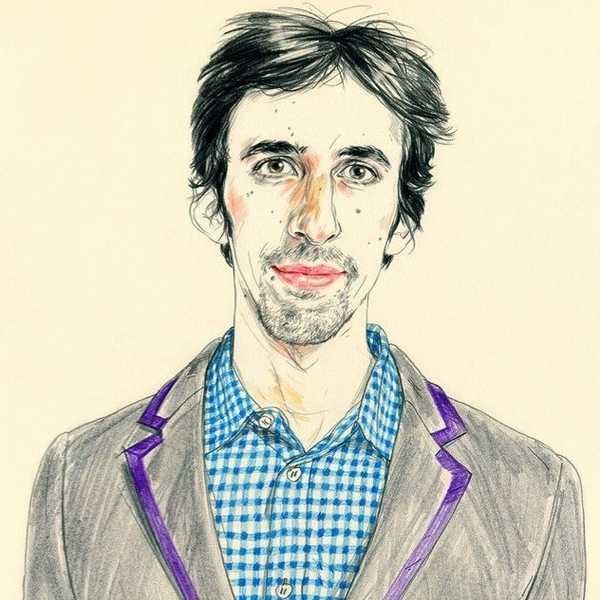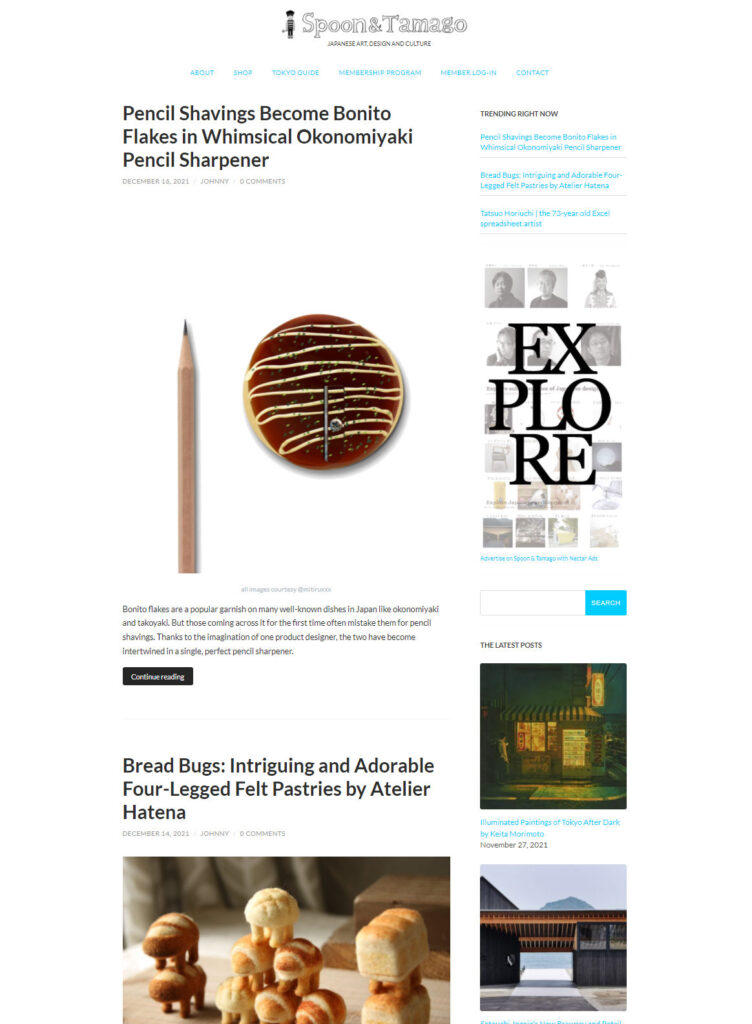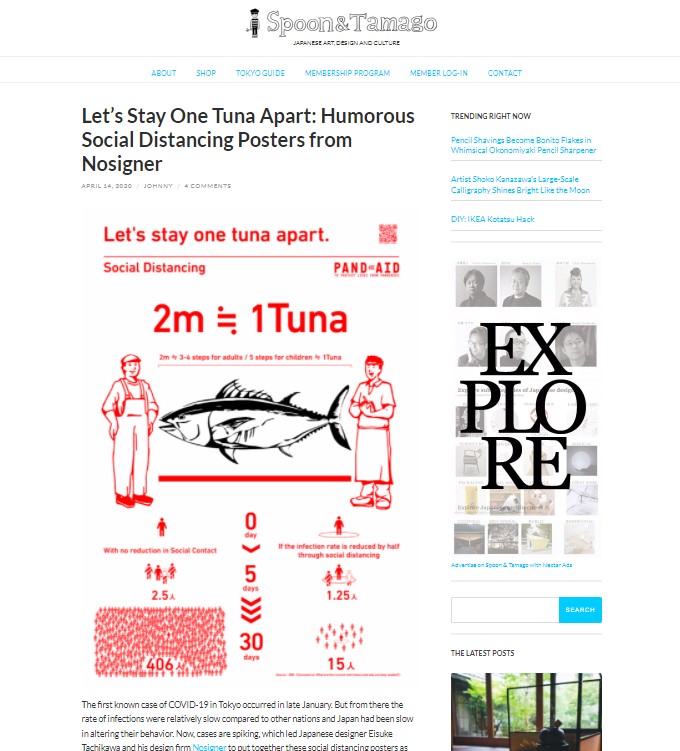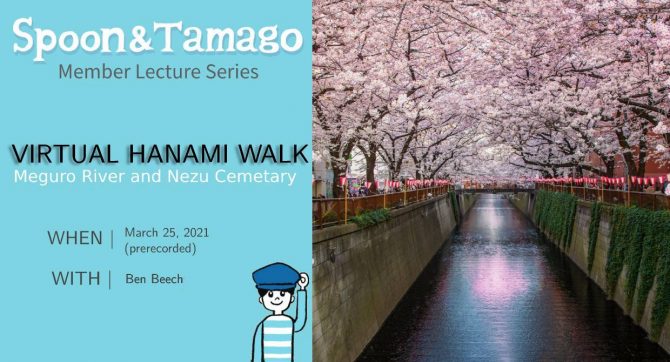Spoon & Tamago is a web media based in Brooklyn, U.S.A. that was launched in 2007 in a current style. While focusing on art and design, it also covers a wide range of modern pop culture, including fashion and music, and provides the world with unique reflections on Japan’s “now” in English from external perspective. Johnny Waldman, who directs the project, was born in New York, lived in Tokyo from the age of 1 to 18, and returned to the U.S. when he entered college. How did he become a Brooklyn-based introducer of Japanese culture, and how does he look at Japanese culture? We interviewed him from Tokyo via ZOOM.
The great influence from the ceramics I encountered in high school
–I heard that you lived in Japan for 18 years from the age of one. Is that right?
Johnny Waldman: My parents had me in Brooklyn and decided to move to Japan when I was one year old. At the time, the economy in New York was not very good, and they thought it was not a good place to raise a child. My parents were interested in Asian culture and religion, and Japan was the best option at the time, given the facet of living. So my parents quit their teaching jobs in the U.S. and moved into an apartment in Koenji. So, my first memory started in Japan.
–When you were in Japan, which culture did you prefer and familiarize yourself with, American or Japanese?
Johnny: We didn’t have a TV at home because my mother was against television. And I rarely had the chance to watch MTV or American music videos, so I was never influenced by American pop culture. My father was a music lover who often played American singer-songwriters such as Bob Dylan and Leonard Cohen, as well as jazz and classical music at home. So I was listening to them naturally, but it was mostly Japanese music that I was listening to voluntarily. I was also familiar with Japanese manga and anime such as Dragon Ball and Slam Dunk.
However, in terms of cultural influences, my encounter with pottery in high school was significant for me. It was Mr. Mori, a teacher at the American School I attended at the time, who sparked my interest in Japanese crafts. He even took me all the way to Chiba on weekends to introduce me to a professional potter. This encounter with traditional Japanese culture had a great impact on my sense of values in the years to come.
–After living in Japan for 18 years, you moved to the U.S. to obtain a bachelor’s degree in art. Please tell us about your feelings at that time.
Johnny: While I lived in Tokyo from the age of 1 to 18, I had only been to the US a few times to visit my family and relatives. So, at that time, the U.S. felt like a completely foreign country to me. However, my parents insisted that I go to a university in the U.S.. Partly because both of them used to be teachers in the U.S., they strongly believed that the American university system would be more favorable to me. In retrospect, I am grateful that I made the right decision thanks to them, but at the time, I experienced a lot of cultural shock and difficulties.
The reason why I was attracted to Japanese art and design
–Please tell us a bit about your web media, “Spoon & Tamago”. Was it launched in 2007?
Johnny: Actually, Spoon & Tamago has existed from before that. I first started using the term maybe around 2003 or 2004. The term derives from a game called “pudding fortune-telling” that was popular on the Internet at the time. With this game, if you enter your name and birth date on it, it will liken you to ingredients or kitchen tools associated with pudding and read your fortune. I got “egg” and my girlfriend at the time, who is now my wife, got “spoon”. We liked the sequence of these words so much that we started using it as the title of our blog. The blog was meant to share ideas about our wedding, and after we got married in 2005 and later had children, it became a very personal place for us where we post pictures of our babies.
–So it started out as yor personal blog, right? When and how did it become what it is today?
Johnny: Around 2007, I started posting interesting ideas and things I liked, mostly related to art and design from around the world. It was because I wanted to make a catalogue of many discoveries I made in my daily life. This led to what Spoon & Tamago is now, but at that time it didn’t focus on Japan yet.
–How did the contents focus on Japan?
Johnny: I think I had a unique “voice” or way of thinking when it came to sharing information about Japanese culture, which were derived from my background. That must have been reflected in my articles, because I received more responses from readers to my articles about Japan than to my articles on topics in other countries. That made me very happy, and I thought, “Okay, let’s do more of that,” and I gradually started to focus on Japan. It was a really natural evolution.
— “Spoon & Tamago” introduces a variety of Japanese culture, from traditional handicrafts to contemporary art and modern pop culture. Please tell us how you select topics.
Johnny: The first criterion was that it had to be something that I liked. Spoon & Tamago” was a result of natural evolution of what I had been doing. After a while, I started to focus more on the perspective and the context. I’m not interested in works or products that just look good.
What attracts me are things that have a story or context behind them, and I am interested in placing them in the context of society and the times, and in documenting the overall flow of the art and design scene in Japan. Apart from that, I also think it is important to shed a light on artists and designers who should be in the spotlight, but whom I feel are currently not.
–What cultural and social topics in Japan are you currently interested in?
Johnny: I’ve been amazed at the creative response of Japanese creators to the pandemic. There are creators who presented a variety of great ideas, including a product designer who has created and released a description of how to make face shields easily and for free (Tokujin Yoshioka: article in Spoon & Tamago: https://www.spoon-tamago.com/2020/04/15/tokujin-yoshioka-face-shield/) and a graphic designer who worked on helping people to take social distance properly(NOSIGNER: article in Spoon & Tamago: https://www.spoon-tamago.com/2020/04/14/pandaid-social- distancing-posters/.) I know that many people are tired of hearing about pandemics and COVID-19. However, I am always amazed and encouraged by the power of art and design to bring about change in society, and it is in time like this that it really shines. Looking ahead to the future, I also pay attention to a trend to focus on more ecological and environmentally friendly products. It’s inspiring to see people using the power of design to reduce packaging and waste, and to implement creative responses to climate change and other important issues.
— I am afraid that this question is too vague, but what do you think are the trends in Japanese design, products, and art compared to those in the US?
Johnny: I feel that there is more attention to materials, textures, and details in Japanese products than in American ones. Perhaps it has something to do with the fact that Japan is an island nation and has a stronger connection with nature. Also, Japan has a lot of history that the U.S. doesn’t have, and I feel that there are a lot of works and products that are inspired by that.
— I learned that the promoter of CHAI’s show in Seattle had read the article you wrote about them on Spoon & Tamago in 2017. How did you get to know CHAI and what attracted you to them?
Jonny: They performed in an event called Japan Night at SXSW in 2017 and I remember being instantly impressed by the very pure and unadulterated energy of these girls. I also found their musicality, which includes various elements that transcend genres and styles, and the fact that they are a all-female band attractive. They are quite rare among Japanese music groups. So I wrote an article on my blog about these girls. Then one day, a few years later, a promoter in Seattle who had read that article emailed me to let me know that the girls would be performing that night, and that the tickets were sold out.
In this way, people who read what I wrote for Spoon & Tamago sometimes come back to me months or even years later and tell me how a particular article or topic has affected them or their surroundings. It’s not something I intended, it’s an unexpected result.
Where the media is now and its future prospective
–Please tell us a bit about the readers and community of “Spoon & Tamago”. Are there many people who have always been very fond of Japan?
Johnny: There are people who are already deeply interested in Japan, but there are also people who have visited Japan just once, and people who are dreaming of visiting Japan someday. Such people are reading our media to look for clues for their travel, places to see, and museums to visit in Japan. I have heard from many readers that they had been reading Spoon and Tamago for 10 years and were finally going to Japan for the first time. I have also heard from Japanese people in Japan that they use “Spoon & Tamago” to study English because it is unique and interesting. In terms of national backgrounds of the readers, about 60% of the accesses are from the U.S., and the rest are from countries like Japan, Europe, Australia, Canada.
–Where does the uniqueness of “Spoon & Tamago” come from?
Johnny: Even though I write about Japan, I look at it from the “outside”. I think not being in Japan allows me to filter out a lot of the noise and appreciate the elements that are truly unique. Also, I can read, write, and speak Japanese, so I don’t have to wait for information to be translated into English. For these reasons, I think we are able to create unique articles and many people, including Japanese readers, are paying attention to us.
— “Spoon & Tamago” also runs an e-commerce site that sells unique items from artists and independent makers. Can you say something about it?
Johnny: E-commerce, which we launched in 2013, is an extension of our blog. We’ve introduced a lot of Japanese products on our blog, but they were things that you couldn’t easily buy in the US. This had frustrated our readers so much that they were sending more and more emails that says “Why can’t I buy it? or “I want to buy it!” So we decided to launch e-commerce because we thought we had to do something about it.
–How did you find your suppliers? Also, how do you select items? Is there any specific criteria for that?
Johnny: In terms of suppliers, I base it on the past archives of my blog. In other words, the blog is a huge resource of things I’ve liked and written in the past. And for the items I sell on my e-commerce site, I have one very important rule: everything I sell there has to be something I have actually used and loved. I didn’t want to create a store that sells any kind of junk, because I wanted to make sure that the products I sell are carefully selected. I’m very selective about the products I deal with.
–In terms of efforts as a media, in addition to e-commerce, you’ve also introduced a membership program.
Johnny: The membership program is a recent project we are working on. The idea behind this program was to diversify our revenue sources. Although we understood how important it was to sell advertising space, it was not the best solution for us nor was it a large part of our business model. When we launched e-commerce in 2013, our primary focus was to move away from advertising. When we faced the pandemic, online sales were very strong because everyone was home. But we soon ran out of stock. With no air service from Japan, we couldn’t even increase our supply from Japan, so we had no choice but to stop the sales of many of our products. In this situation, the introduction of the membership program has allowed us to take the next step in terms of diversifying our revenue source.
The introduction of it is partly to maintain our business, but also to keep our readers in direct contact with information about Japan. We offer a variety of content, such as a small class on kintsugi, or a performance by a rakugo storyteller. In March this year, we had a “virtual hanami” with the help of an acquaintance in Japan. We watched the cherry blossoms along the Meguro River in front of computers all over the world. It was a very nice place.
–Do you have any favorite spots or stores in Japan?
Johnny: Hokkaido is one of my favorite places in Japan. There is so much beautiful nature, good food, and so much to see and explore. Moerenuma Park, designed by Isamu Noguchi, is an amazing spot.
In Tokyo, I am more familiar with the areas around Koenji, Kichijoji, and Mitaka, where I grew up, but whenever I visit Tokyo, I am always amazed at how many neighbourhoods and areas that I have yet to explore. And the best thing about Tokyo is that it is a very walkable city. Biking is fine, but I prefer to walk. When I go on a business trip to Japan, I pick one day to just walk an entire neighborhood up and down and all the side streets. And I can find many small stores and galleries that I would never see by bus, car, or train. I don’t really have a favorite spot in Tokyo, but rather I like making such new discoveries and encounters.
–Finally, please tell us about your future plans.
Johnny: As I said earlier, we don’t really believe in massive growth or expansion. Fortunately, we don’t have any investors. So we’ll just keep doing what we’re doing, highlighting the artists and things we love, and the culture and tradition. As an extension of that, we hope to have our own cafe and gallery space. Real estate in New York is very expensive, so it’s still a pipe dream at this point though. But I’d like to try it someday.

Johnny Waldman
Johnny was born in Brooklyn but moved to Tokyo a year later. He spent the first 18 years of his life growing up in Tokyo where his parents taught English. He returned, for the first time, to the United States to attend college where he earned his bachelor’s degree in Art Education and his BFA in Art and Visual Technology. He also completed intensive studies in art history. He is currently based in Brooklyn but travels frequently to Tokyo.
Twitter: @Johnny_suputama
Spoon & Tamago: https://www.spoon-tamago.com/
Translation Shinichiro Sato(TOKION)




